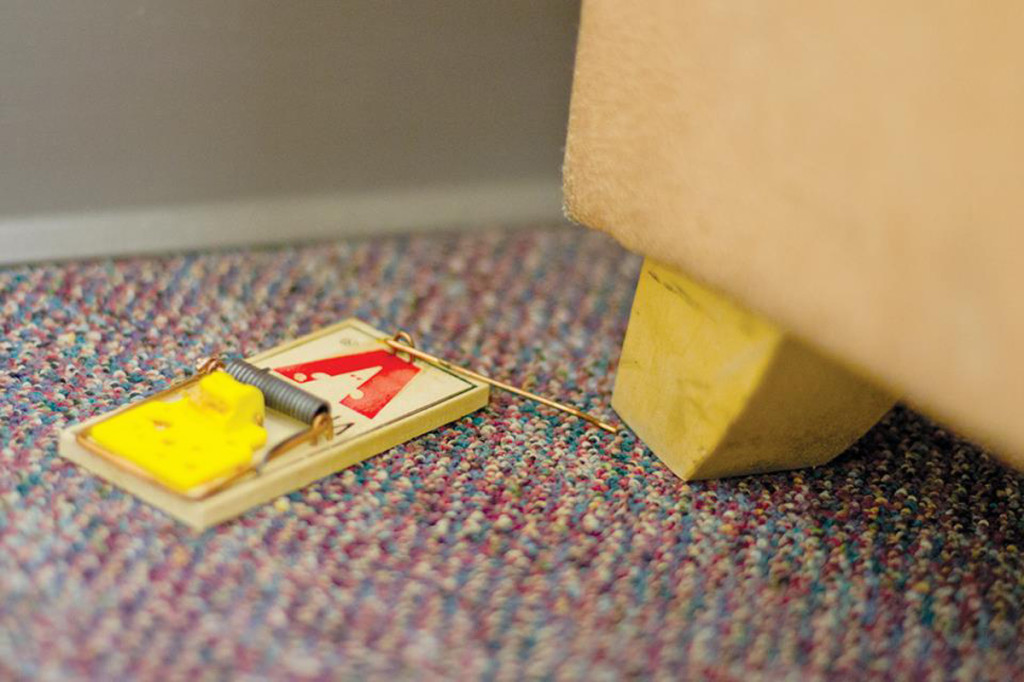Despite about 40 calls made to the Facilities Resource Center last week regarding sightings of mice, there has actually not been an influx in mouse population on campus.
“We wouldn’t necessarily call it an infestation,” said Thom Sullivan, manager of Seattle University’s Facilities Resource Center. “Last week I think we had just under 40 calls in about mice, but just two or three work orders placed.”
According to Sullivan, there have only been about three occurrences of indoor mouse activity; there are so many calls because multiple people report each sighting.

Mice are controlled on campus using traps, many of which are actually humane traps. These, unlike the trap featured here, do not kill the mouse, instead they are contained in a box until removed by a groundskeeper.
“I think 15 different people called about the same mouse,” Sullivan said.
According to Sullivan, one of the sightings that kept being reported was in James C. Pigott Pavilion for Leadership, and the other two were on the third floor of the Pigott building.
Freshmen Kayla Todd and Shannon Sullivan-Moore say that they’ve often seen mice outdoors, but never inside of a building.
After the large amount of phone calls regarding mice, the Facilities Resource Center sent out an email via Campus News addressing the issue. According to Sullivan, the purpose of the email was to spread awareness; if people know about mice, they will hopefully be more conscious about how they can act so as to not encourage mouse activity. There was also the hope that less calls would be made if people knew that it was being looked into.
“We do respond to every single call about a mouse,” Sullivan said. He pointed out that with only two people fielding calls in the office, an influx of reports isn’t as helpful as one work order filed per sighting. Additionally, if they have to respond to every single call, they’re sending the same people to the same spaces over and over again.
In the email from the Facilities Resource Center are included some recommendations about how people can modify their behavior to not encourage mice. These include “limit food consumption at your workspace,” and “all food storage should be kept in air-tight containers.” All four tips have to do with the handling of food, because it’s something that will attract mice.
These recommendations come from Paratex, the pest control company that has been working with Seattle U for approximately the past 18 months. According to General Manager for Paratex Pest Control Ray Williamson, they were initially hired to help with rat issues, which they cleared up. While Williamson says that less rats allows more mice, both he and Sullivan maintain that the influx of mouse reports is not the product of a growing population.
“In the springtime we always see a little bit of an increase when the weather gets better, but it hasn’t been anything out of the normal by any means,” Sullivan said.
In addition to springtime being a usual time to see mice, Williamson adds that there are other factors that confirm that the increase in sightings is not a surge in population. It’s a product of disruption, not infestation, he said.
Paratex also contracts for many of the businesses surrounding Seattle U, including Swedish Hospital. Williamson says that the amount of construction in the area disturbs the mice’s natural areas and causes them to be seen more. He likened it to decorations around Christmas. In the decorating process, things get moved around, settled, and moved around again. Mice have the chance to resituate and be disturbed in the shuffle. It looks worse, but it isn’t.
The Facilities Resource Center maintains that while there is increased mouse activity, this does necessarily imply that there is an abnormally large population.
“With the ground saturated with water, mice that live underground are seeking new nesting habitats on high ground, and ongoing construction in the neighborhood is also uprooting their established nesting habitat. Spring is right around the corner, which is mating season for the mice. Food and drinks being left out in campus locations are also
contributing factors,” wrote Facilities in an email to various departments.
Paratex normally comes to Seattle U at least once a week for regular maintenance. To handle the mice, they normally set bait stations outside, and glue traps inside. Paratex decides how many bait stations Seattle U should have based on acreage, as well as suggest other things to help the university avoid a mouse problem.
“They make recommendations to us as far as how to maintain the landscaping to make it less attractive to rodents,” Sullivan said.
The glue traps are checked by Paratex a couple of times a week. According to Sullivan, the glue traps aren’t very successful, but he thinks there’s a lot of worth in awareness about the mice so that people can adjust their behavior to not encourage their presence. A lot of times, Sullivan said, the mice just leave instead of getting caught. But then they’re at least out of the area.
“They’d much rather not be inside,” Sullivan said. The mice themselves were not available for comment.












